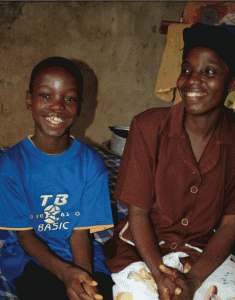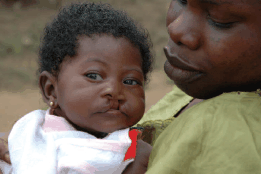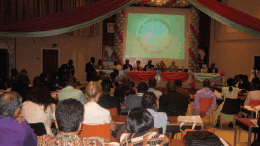(This Article originally appeared in Scope, the news magazine of Loma Linda University, Fall 2006 edition)

Harvest is an 11-year old boy in Nigeria. He’s teased at school and his father left him and his mother—all because of his cleft lip and palate. Harvest is just one of an estimated 360,000 people in Africa born with clefts. That’s why Loma Linda University, Adventist Health International (AHI), and the Smile Train—a nonprofit organization that is committed to eradicating the problem of cleft lips and palates went on board to help children who face this problem. From February 13 to 15, 2006, LLU, AHI, and the Smile Train sponsored the first ever Pan-African Congress on Cleft Lip and Palate. About 150 health professionals from 12 different countries in Africa participated in the conference held in Ibadan, Nigeria. “Loma Linda University and Adventist Health International were delighted to be partners in this worthy endeavor,” shares Richard Hart, MD, DrPH, chancellor of LLU and president of AHI.
“The Smile Train is working hard to expand our programs throughout Africa,” says president and co-founder Brian Mullaney. “Overall, we plan to train hundreds of surgeons and operate on thousands of children in the coming year.” According to Smile Train’s vice president, DeLois Greenwood, the Smile Train only helped 500 children in Africa out of the 35,000 they have helped worldwide last year. “When we wanted to expand our programs in Africa and met with Dr. Hart,” explains Ms. Greenwood, “we realized that LLU and AHI might be our spark that helps us reach the medical professionals because they have the network, resources, and reputation. And I dare say, had it just been the Smile Train, participants may not have come. But the fact there’s an affiliation with such a famous institution, the surgeons were quite interested.”
“To organize a conference in Africa is no small feat,” explains Dr. Hart. “We are particularly blessed with two people who helped put this together. Dr. Linda D’Antonio and Tomi Daniel were absolutely essential.” Linda D’Antonio, PhD, professor, School of Medicine, is a speech pathologist and a member of the medical advisory board of the Smile Train. Tomi Daniel, BL, a lawyer in Nigeria and wife of Danjuma Daniel, business manager of AHI–Nigeria, volunteered her time to help plan the event.
Last year, Dr. D’Antonio and Ms. Daniel met at an AHI meeting in Loma Linda. Dr. D’Antonio explained to Ms. Daniel how she was told clefts didn’t exist in Nigeria. So Ms. Daniel gladly accepted photos of children before and after they had their cleft repaired. She took them back to Nigeria and showed the photos around town, asking if they knew anyone with this problem. The result was overwhelming. Ms. Daniel found numerous people with clefts. During her search, Ms. Daniel learned that the word used for cleft in her region of Nigeria is chuandaji, meaning wild disease, something that cannot be cured.
“Taking the photos around restored hope,” shares Ms. Daniel. “It showed that clefts are not hopeless. It was a privilege to be a part of restoration for someone’s life.” After discovering the problem with clefts in Nigeria, the next step involved several months of intense planning for the first ever Pan African Congress on Cleft Lip and Palate (PACCLIP). PACCLIP was deemed a huge success and throughout the course of three days, about 150 health professionals participated in lectures, interactive seminars, and surgical videotaped demonstrations in order to establish a sustainable cleft care program in Africa.
“We were so excited and so surprised on the first day when they asked people to stay and form the Nigerian Cleft Lip and Palate Association,” says Dr. D’Antonio. “In my wildest dreams, I couldn’t imagine the excitement and joy of watching this unfold in front of me. “On the last day of the meeting, they didn’t want to leave. So they had an impromptu meeting and what was born was the Pan African Cleft Lip and Palate Association. That will be a high in my career that will be very hard to ever top. Smile Train, Loma Linda University, and Adventist Health International can be very proud of the stepping-stone that they provided that resulted in this association for the continent.
“I believe that the formation of that association is perhaps the greatest legacy of this meeting and the support from the three sponsoring organizations,” adds Dr. D’Antonio. The goals of the conference were to: identify existing cleft care providers and programs within Africa; make available a platform for those already providing cleft care in Africa to network and share their experience; raise public awareness about cleft lip and palate and to inform the public that cleft lip and palate can be surgically corrected; and to provide education and training for surgeons regarding the care of children with cleft lip and palate.
The 2006 Pan African Congress on Cleft Lip and Palate led to Smile Train’s request—that AHI and LLU plan and organize two more meetings within Africa in 2006-2007. In return, Smile Train would sponsor the finances of the meeting. “One of the outcomes of PACCLIP,” shares Dr. D’Antonio, main organizer of the event, “was the development of a small but extremely helpful network of surgeons who have continued over the year to provide valuable information regarding the challenges and solutions for increasing cleft care in Africa.”
These surgeons have expressed repeatedly that the challenges for providing cleft care in Africa are unique and therefore require “African specific” solutions in order to build Smile Train partnerships. Because of that, Dr. D’Antonio planned the Smile Train Consensus Conference on Strategies for Increasing Cleft Care in Africa. Held in Nairobi, Kenya, from September 27 to 28, the purpose of the conference was to invite these surgeons and other key stakeholders “to tap into their wisdom about local problems and local solutions to increase cleft care,” explains Dr. D’Antonio.
Thirty-six participants from across sub-Saharan Africa attended the conference. The first day of the conference included an environment scan where participants discussed where cleft providers previously were, where they currently are, and where they are going. Then they talked about the trend analysis. For example, attendees concluded that they went from awareness of needs to capacity building, from solo care to team care, from neglect to awareness, etc. Other discussions included strategies that are for African solutions to increase cleft care. Strategies included: 1) developing funding models that enhance capacity building, 2) capacity building for improved cleft care, 3) building a network and encouraging researchers in cleft lip and palate, 4) establishing standard treatment protocols as an aid to auditing, hence improved quality, and 5) improved level of awareness of cleft care.
Dr. D’Antonio noted that it would be easy to send one team to provide cleft care for a couple of weeks in Africa for the same amount of money that was used to empower the participants of this conference. “This time, however, we developed partners and solutions that will impact the whole entire continent,” she says. “Now participants will be the teachers and light the fires in the bellies of the next generation of cleft surgeons.”
Themba Nyirenda, DDS, an oral surgeon in Malawi, says, “It is pleasing to note that Africa has a wealth of talent, which once properly harnessed, will achieve lasting solutions to our cause. At this point and time, we cannot afford to be complacent. We need to build up, not down.”
The next step is PACCLIP 2007, to be held in February in Ibadan, Nigeria. Thanks to LLU, AHI, and the Smile Train, 11-year-old Harvest and many other children will get their clefts repaired—defeating chuandaji, the “wild disease.”


